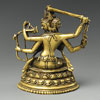Crowns of the Vajra Masters: Ritual Art of Nepal
Manjuvajra, an Esoteric Manifestation of Manjushri
Eastern India, Bihar, Pala period, 11th–12th century
Copper alloy, inlaid with silver and copper; base sealed later in Tibet
H. 4 1/4 in. (10.8 cm); W. 3 5/8 in. (9.2 cm); D. 1 7/8 (4.8 cm)
Lent by a private collection
This six-armed form of Manjushri emerged in esoteric Buddhist imagery late in the Pala period. A visualized form of the bodhisattva Manjushri, Manjuvajra is described in the Nishpanna Yogavali (Garland of Perfection Yoga) as providing a path to wisdom and intelligence. The crossed hands at his chest invoke the embrace of his consort, Prajna (meaning “wisdom”). The display of weapons references his dispelling of ignorance, and the wisdom book (pustaka) symbolizes the path to spiritual awakening.
Inscription: Base sealed later in Tibet
Exhibition History
New York. The Metropolitan Museum of Art. "Crowns of the Vajra Masters: Ritual Art of Nepal," December 16, 2017–December 16, 2018.

